2019-7-21 16:46:53
STL 源码剖析 –侯捷
STL概论与版本简介
STL六大组件
- 容器(containers):vector.list.deque,set,map等数据存放的类。
- 算法(algorithms):各种排序算法;sort、search、copy、erase..等
- 迭代器(iterators):扮演容器与算法之间的胶合剂,即泛型指针
- 功能函数(functors):行为类似函数,可以视为算法的某种策略
- 配接器(adapters):一种用来修饰容器(containers)或仿函数(functors)或迭代器(iterators)借口的东西
- 配置器(allocators):负责空间配置与管理
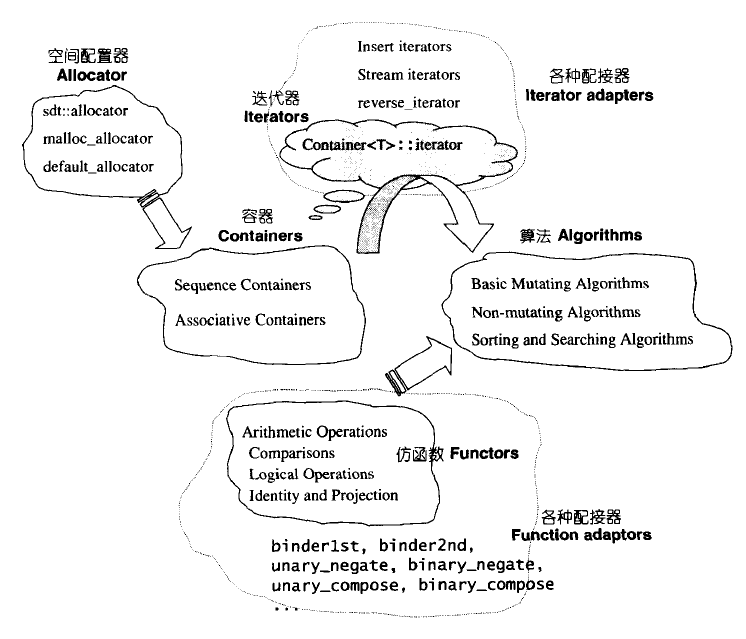
第二章 空间配置器
allocator是空间配置器,定义于头文件
成员类型
| 类型 | 定义 |
|---|---|
| value_type | T |
| pointer (C++17 中弃用)(C++20 中移除) | T* |
| const_pointer (C++17 中弃用)(C++20 中移除) | const T* |
| reference (C++17 中弃用)(C++20 中移除) | T& |
| const_reference (C++17 中弃用)(C++20 中移除) | const T& |
| size_type | std::size_t |
| difference_type | std::ptrdiff_t |
| propagate_on_container_move_assignment(C++14) | std::true_type |
| rebind (C++17 中弃用)(C++20 中移除) | template< class U > struct rebind { typedef allocator other; }; |
| is_always_equal(C++17) | std::true_type |
成员函数
| 函数 | 定义 |
|---|---|
| (构造函数) | 创建新的 allocator 实例(公开成员函数) |
| (析构函数) | 析构 allocator 实例(公开成员函数) |
| address(C++17 中弃用)(C++20 中移除) | 获得对象的地址,即使重载了 operator&(公开成员函数) |
| allocate | 分配未初始化的存储(公开成员函数) |
| deallocate | 解分配存储(公开成员函数) |
| max_size(C++17 中弃用)(C++20 中移除) | 返回最大的受支持分配大小(公开成员函数) |
| construct(C++17 中弃用)(C++20 中移除) | 在分配的存储构造对象(公开成员函数) |
| destroy | (C++17 中弃用)(C++20 中移除)析构在已分配存储中的对象(公开成员函数) |
下面是一个std::allocator的简单实现
注意这里的size_t与操作系统相关,32位是4字节,64位时8字节;ptrdiff_t是两个指针相减的结果类型,是一种有符号整数类型。减法运算的值为两个指针在内存中的距离。ptrdiff_t是signed类型,用于存放同一数组中两个指针之间的差距,它可以使负数,std::ptrdiff_t.同上,使用ptrdiff_t来得到独立于平台的地址差值.
#include <new.h>
#include <stddef.h>
#include <limits.h>
#include <iostream.h>
#include <algobase.h>
template <class T>
inline T* allocate(ptrdiff_t size,T*)
{
//设置新句柄
set_new_handler(0);
T* tmp=(T*)(::operator new((size_t)(size* sizeof(T))));
if(tmp==0)
{
cerr<<"out of memory"<<endl;
exit(1);
}
return tmp;
}
template <class T>
inline void_deallocate(T* buffer)
{
::operator delete(buffer);
}
template <class T1,class T2>
inline void _construct(T1* p,const T2& value)
{
new(p) T1(value);
}
inline void _destroy(T* ptr)
{
ptr->~T();
}
//allocator类的基本实现
template <class T>
class allocator
{
public:
typedef T value_type;
typedef T* pointer;
typedef const T* const_pointer;
typedef T& reference;
typedef const T& const_reference;
typedef size_t size_type;
typedef ptrdiff_t size_type;
//连接 allocator和U
template <class U>
struct rebind
{
typedef allocator<U> other;
};
//获取左值指针
pointer allocate(size_type n,const void* hint=0)
{
//分配内存并初始化为0
return _allocate((difference_type)n,(pointer)0);
}
void deallocate(pointer p,size_type n){_deallocate(p);}
void address(reference x){return (pointer)&x;}
const_pointer const_address(const_reference x)
{
return (const_pointer)&x;
}
size_type max_size() const
{
return size_type(UINT_MAX/sizeof(T));
}
};
上面只是简单的allocator实现,真实情况比这个要复杂的多。 SGI标准的空间配置器,是对::operator new和::operator delete做了一层薄薄的封装。
STL allocator将两阶段操作区分开来。内存配置操作由alloc:allocate()负责;内存释放操作由alloc::deallocate()负责;对象构造操作由::construct()负责,对象析构操作由::destroy()负责。
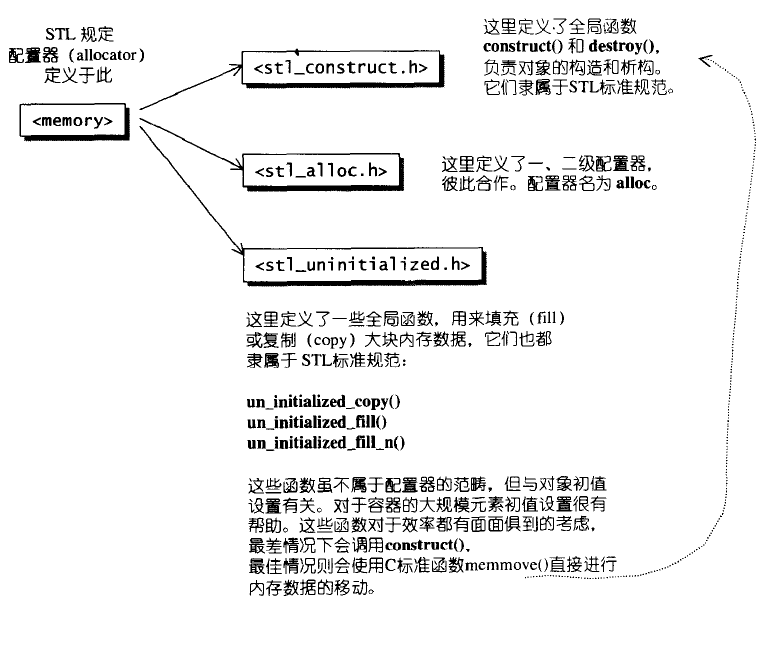
2.2.3 构造和析构基本工具: construct()和destory()
下面是c++1中 stl_construct.h的部分内容
#ifndef _STL_CONSTRUCT_H
#define _STL_CONSTRUCT_H 1
#include <new>
#include <bits/move.h>
#include <ext/alloc_traits.h>
namespace std _GLIBCXX_VISIBILITY(default)
{
_GLIBCXX_BEGIN_NAMESPACE_VERSION
/**
* Constructs an object in existing memory by invoking an allocated
* object's constructor with an initializer.
*/
//c++11 新添加Construct函数
#if __cplusplus >= 201103L
template<typename _T1, typename... _Args>
inline void
_Construct(_T1* __p, _Args&&... __args)
{ ::new(static_cast<void*>(__p)) _T1(std::forward<_Args>(__args)...); }
#else
template<typename _T1, typename _T2>
inline void
_Construct(_T1* __p, const _T2& __value)
{
// _GLIBCXX_RESOLVE_LIB_DEFECTS
// 402. wrong new expression in [some_]allocator::construct
::new(static_cast<void*>(__p)) _T1(__value);
}
#endif
/**
* Destroy the object pointed to by a pointer type.
*/
//接受指针,并直接调用指针类的析构函数
template<typename _Tp>
inline void
_Destroy(_Tp* __pointer)
{ __pointer->~_Tp(); }
//模板函数
template<bool>
struct _Destroy_aux
{
template<typename _ForwardIterator>
static void
__destroy(_ForwardIterator __first, _ForwardIterator __last)
{
for (; __first != __last; ++__first)
std::_Destroy(std::__addressof(*__first));
}
};
//特例化函数判断对象是否含有默认构造函数,如果是则什么也不做,这样可以提高效率
template<>
struct _Destroy_aux<true>
{
template<typename _ForwardIterator>
static void
__destroy(_ForwardIterator, _ForwardIterator) { }
};
/**
* Destroy a range of objects. If the value_type of the object has
* a trivial destructor, the compiler should optimize all of this
* away, otherwise the objects' destructors must be invoked.
*/
//销毁一系列对象。如果对象的value_type是一个默认的析构函数,编译器应该优化所有这些,否则必须调用对象的析构函数。
template<typename _ForwardIterator>
inline void
_Destroy(_ForwardIterator __first, _ForwardIterator __last)
{
//迭代器别名
typedef typename iterator_traits<_ForwardIterator>::value_type
_Value_type;
std::_Destroy_aux<__has_trivial_destructor(_Value_type)>::
__destroy(__first, __last);
}
/**
* Destroy a range of objects using the supplied allocator. For
* nondefault allocators we do not optimize away invocation of
* destroy() even if _Tp has a trivial destructor.
*/
//使用支持的allocator销毁一系列对象,如果没有非默认的allocators不会进行销毁函数的初始化,即便,对象含有默认构造函数
template<typename _ForwardIterator, typename _Allocator>
void
_Destroy(_ForwardIterator __first, _ForwardIterator __last,
_Allocator& __alloc)
{
typedef __gnu_cxx::__alloc_traits<_Allocator> __traits;
for (; __first != __last; ++__first)
__traits::destroy(__alloc, std::__addressof(*__first));
}
template<typename _ForwardIterator, typename _Tp>
inline void
_Destroy(_ForwardIterator __first, _ForwardIterator __last,
allocator<_Tp>&)
{
_Destroy(__first, __last);
}
_GLIBCXX_END_NAMESPACE_VERSION
} // namespace std
#endif
上述代码中_Destroy_aux主要是用来检测,对象是否有自定义的析构函数,如果有就进行迭代调用。如果没有(使用默认析构函数)直接跳过,避免资源浪费。
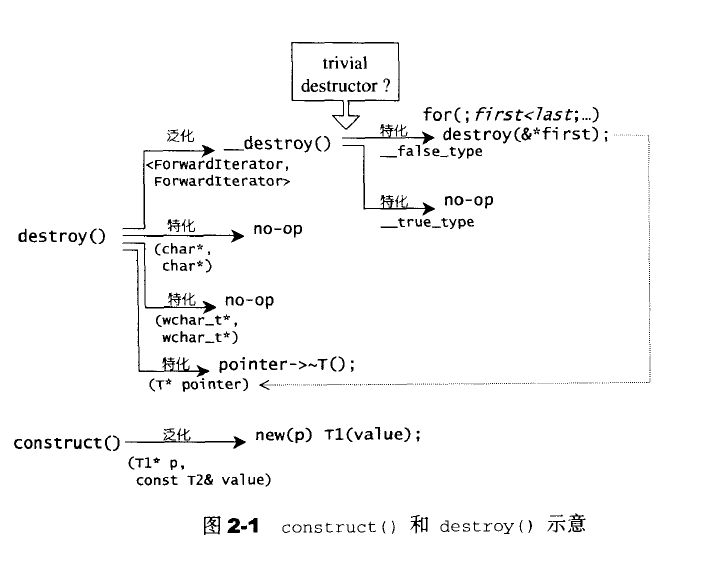
2.2.4 空间的配置与释放,std::alloc
构造空间的配置与释放,由
- 向
system heap请求空间 - 考虑多线程状态
- 考虑内存不足时的应变措施
- 考虑过多“小行区块”可能造成的内存碎片(fragment)问题。
考虑到小型区块可能造成的内存破碎问题,SGI设计了双层级配置器,第一级配置器直接使用malloc()和free();第二级配置器则视情况采用不同的策略。当配置区块超过128byte时,视之为足够大,使用第一级配置器,当小于128byte时,视之为过小,采用复杂的memory pool整理方式。而不再求助于第一级适配器。使用哪一级适配器取决于__USE_MALLOC是否被定义。
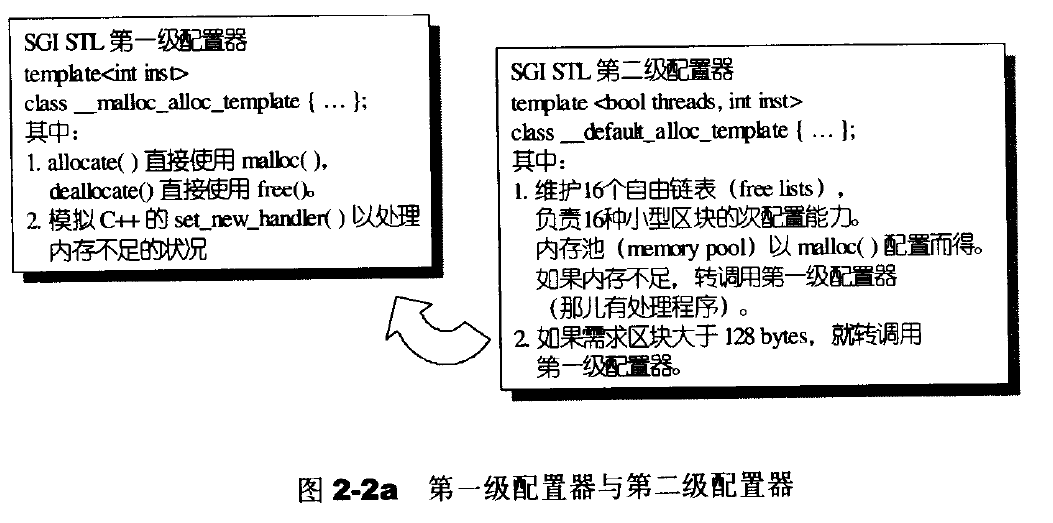
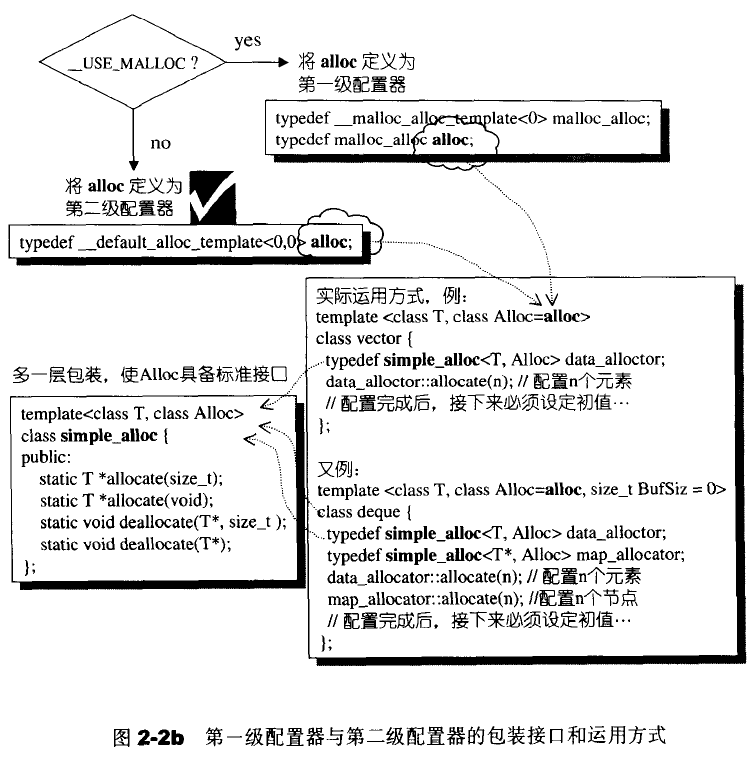
2.2.5 一级适配器__malloc_alloc_template剖析
//一级适配器
template <int inst>
class __malloc_alloc_template
{
private:
//函数指针,所代表的函数将用来处理内存不足的情况
//oom: out of memory
static void *oom_malloc(size_t);
static void *oom_realloc(void*,size_t);
static void (*__malloc_alloc_oom_handler)();
public:
static void *allocate(size_t n)
{
//一级配置器必须使用malloc()
void *result=malloc(n);
//当无法满足需求时,改用oom_malloc()
if(0==result) result=oom_malloc(n);
return result;
}
static void deallocate(void *p,size_t)
{
//第一级配置器直接使用free()
free(p);
}
//输入旧size和新size
static void* reallocate(void *p,size_t,size_t new_sz)
{
void* result=realloc(p,new_sz);
if(0==result) result=oom_realloc(p,new_sz);
return result;
}
//指定自己的out-of-memory handler
static void (* set_malloc_handler(void(*f)()))()
{
//获取函数指针
void (* old)()=__malloc_alloc_oom_handler;
__malloc_alloc_oom_handler=f;
return(old);
}
};
//下面是用户提供的malloc_alloc函数
template <int inst>
void (*__malloc_alloc_template<inst>::__malloc_alloc_oom_handler)()=0;
template <int inst>
void *__malloc_alloc_template<inst>::oom_malloc(size_t n)
{
//获取内存分配句柄函数指针
void (*my_malloc_handler)();
void *result;
for(;;)
{
//指针指向分配函数
my_malloc_handler=__malloc_alloc_oom_handler;
//分配失败抛出异常
if(0==my_malloc_handler){__THROW_BAD_ALLOC;}
//调用处理例程,企图释放内存
(*my_malloc_handler)();
//再次尝试分配内存
result=malloc();
if(result) return(result);
}
}
//内存调用分配不成功时,进行二次调用
template <int inst>
void * __malloc_alloc_template<inst>::oom_realloc(void *p,size_t n)
{
void (*my_malloc_handler)();
void *result;
for(;;)
{
my_malloc_handler=__malloc_alloc_oom_handler;
if(0==my_malloc_handler){__THROW_BAD_ALLOC;}
//尝试调用处理例程
(*my_malloc_handler)();
//尝试分配内存
result=realloc(p,n);
if(result) return(result);
}
}
//注意,以下参数直接将inst指定为0
typedef __malloc_alloc_template<0> malloc_alloc;
2.2.6 第二级适配器 __default_alloc_template 剖析
因为对于操作系统而言,需要块分配一定的内存来存储块的位置信息,因此当内存过小时,单独开辟块反而是得不偿失的。因此在此时,C++使用内存池机制来对数据进行管理。由配置器负责内存的管理和回收,通常SGI配置其会将小额区块的内存需求量上调至8的倍数(例如30B-32B),并唯独16个free-list,各自管理大小分别为8,16,24,3,,40,48,56,64…128 bytes的小额区块。结构如下:
union obj{
union obj* free_list_link;
char client_data[1];
}
因为使用了union因此第一个指针直接指向了内存地址(c++ –> union介绍)。
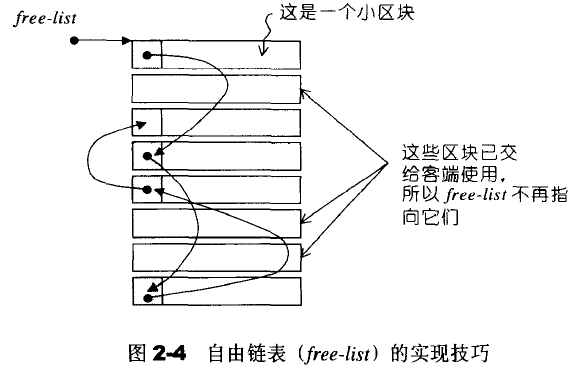
2.2.7 空间配置函数allocate()
__default_alloc_template拥有配置器的标准接口函数allocate()。此函数首先判断区块大小,大于128bytes就调用第一级配置器,小于128bytes就检查对应的free list。如果有可用区块就直接拿来用,没有就将区块的大小上调至8倍数边界,然后调用refill()准备为free list重新填充空间。
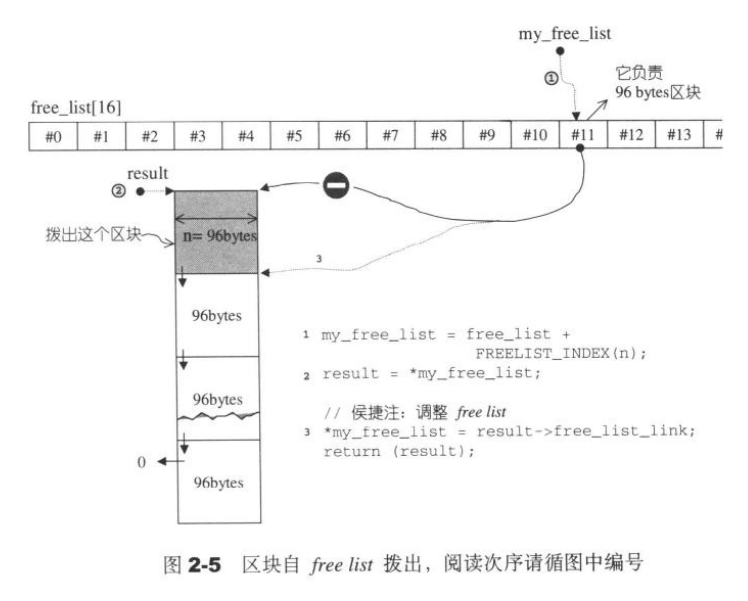
2.2.8 空间释放函数 deallocate()
对于deallocate()函数首先判断区块大小,大于128bytes就调用第一级配置器,小于128bytes就找出对应的free list,将区块回收。

2.2.9 重新填充 free-list
当内存池中没有可用区块的时候,就调用refill()准备为free-list重新分配空间。新的空间将取自内存池,缺省取得20个新节点(新区块),但万一内存池空间不足,获得的节点数(区块数)可能小于20。
2.2.10 内存池(memory pool)
参考链接: C++实现内存池;
上文中提及使用内存池中的内存,提供给free-list方便存取内存。内存池主要是和线程池类似,使用预先分配来实现内存的集中分配和同一管理
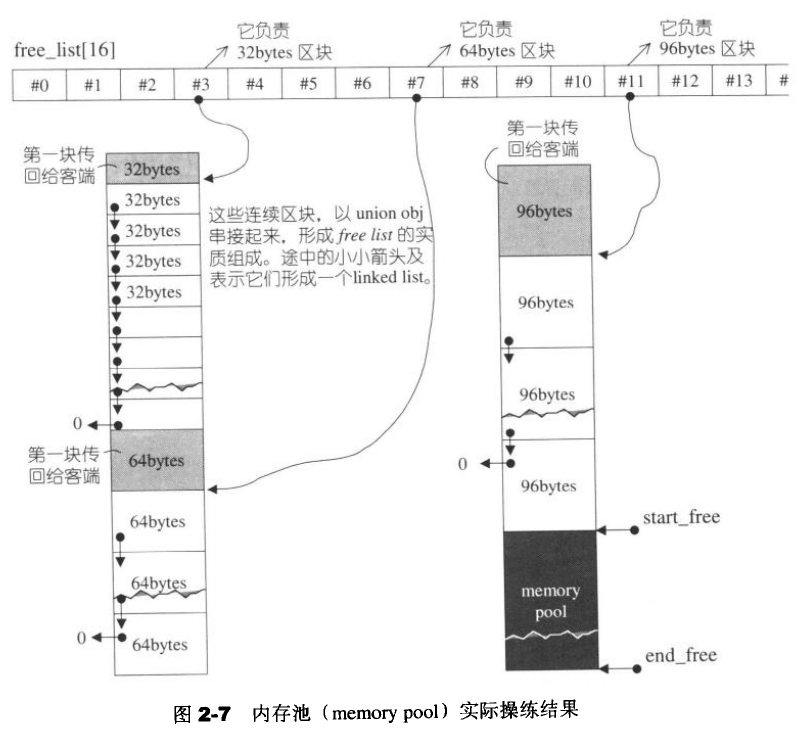
2.3 内存基本处理工具
STL中定义有5个全局函数,作用于未初始化空间之上。分别是construct()、destroy()、uninitailized_copy()、uninitailized_fill()、uninitialized_fill_n();分别对应于高层次函数copy()、fill()、fill_n();后面几个函数定义于
- uninitialized_fill_n((_ForwardIterator __first, _Size __n, const _Tp& __x)):它接受三个参数;并通过value_type来判断对象有没有构造函数,有就进行,没有直接跳过。
- 迭代器 frist指向初始化空间的起始处
- n表示分配内存的数量
- x表示进行内存分配时候的初值
- uninitialized_copy(_InputIterator __first, _InputIterator __last,_ForwardIterator __result);输入参数列表如下,它调用了
__uninitialized_copy()函数,并且通过value_type来判断是否为POD(传统基本数据类型含有拷贝构造等函数),是则直接使用std::copy()进行构造。不是就使用遍历并使用td::_Construct调用类的构造函数进行构造。- frist 迭代器
- last 迭代器
- 表示最终结果
- uninitialized_fill(_ForwardIterator __first, _ForwardIterator __last,const _Tp& __x)和上面一样也是需要判断POD来决定使用构造方式和类型。
- frist 迭代器
- last 迭代器
- 表示最终结果
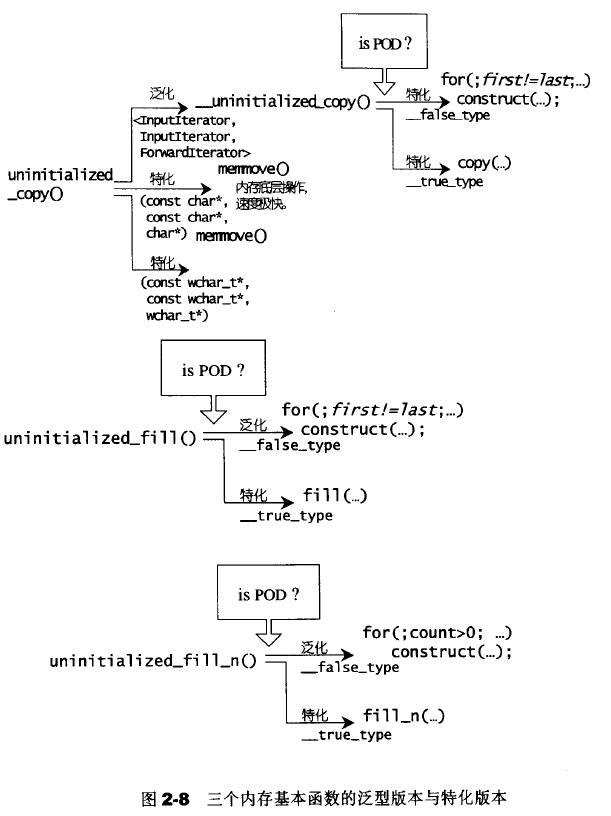
这一章主要讲述了STL中的alloctor通过源码解析,我们发现其实STL的迭代器使用了struct来进行构造,内部还是使用了指针运算符,而所谓的value_type也是指针相关的别名,感觉编译器厂商偷懒了,不过标准库的泛用性得到了保证。而且关于内存池确实是很好的亮点。慎用STL;
第三章 迭代器(iterators) 概念与traits编程技法
迭代器是一種抽象設計的概念,實現程序語言中並沒有直接對應的概念的實物。使用的23種設計模式中的迭代器模式:提供一種方法可以依次訪問某個聚合物所含的各個容器的元素。STL的中心思想在於:將數據容器和算法分開來。而迭代器就是扮演着兩者之間的膠合劑角色。
3.2 迭代器是一種 smart pointer
迭代器是一種行爲類似指針的對象,指针中最常见也最重要的行为便是间接引用(dereference)和成员访问(member access),因此迭代器最重要的就是对operator*和operator->进行重载操作。c++STL中有一个auto_ptr(11中已经废弃),是用来包装一个原生指针(native pointer)的对象。可以解决各种内存漏洞。下面是auto_ptr的源码精要。
template<class T>
class auto_ptr
{
public:
explicit auto_ptr(T *p=0):pointer(p){}
template<class U>
auto_ptr(auto_ptr<U>& rhs):pointee(rhs.release()){}
~auto_ptr(){delete pointee;}
template<class U>
auto_ptr<T>& operator=(auto_ptr<U>& rhs)
{
if(this!=&rhs) reset(rhs.release());
return *this;
}
T& operator*() const {return *pointee;}
T* operator->() const {return pointee;}
T* get() const {return pointee;}
private:
T *pointee;
}
下面是一个简单迭代器
template <class Item>
struct LisIter
{
Item* ptr;
ListIter(Item* p=0):ptr(p){}
//关键操作
Item& operator*() const {return *ptr;}
Item* operator->() const {return ptr;}
ListIter& operator++()
{
ptr=ptr->next();
return *this;
}
ListIter operator++(int)
{
ListIter tmp=*this;
++*this;
retrun tmp;
}
bool operator==(const ListIter& i) const
{
return ptr!=i.ptr;
}
};
迭代器的另外一个非常重要的功能就是隐藏其中的细节;这一点标准库已经做的很好了。
3.3 迭代器相应型别(associated types)
迭代器相应型别是一种类似的封装行为,并不只是“迭代器所指对象的型别”
3.4 Traits编程技法–STL源码门钥
迭代器所指的型别,称为该迭代器的 value type。value用于函数的传回值就无法正常工作了。使用内嵌类型可以很好的避免这种问题。
template <class T>
struct MyIter
{
//内嵌类型声明
typedef T value_type;
T* ptr;
MyIter(T* p=0):ptr(p){}
T& operator*() const {return *ptr;}
}
template <class I>
typename I::value_type func(I ite){return *ite;}
MyIter<int> ite(new int(8));
cout<<func(ite);
上面可以实现对类的特例化别名,但是对于基本数据类型却不可以,因此我们需要使用特例化模板template<>来对基本的数据类型进行封装;STL中提供了traits特性来对数据进行封装和改进。
traits意义在于,如果I定义有自己的value type,那么通过这个traits的作用,萃取出来的value_type就是I::value_type。这样traits就可以拥有特例化版本。
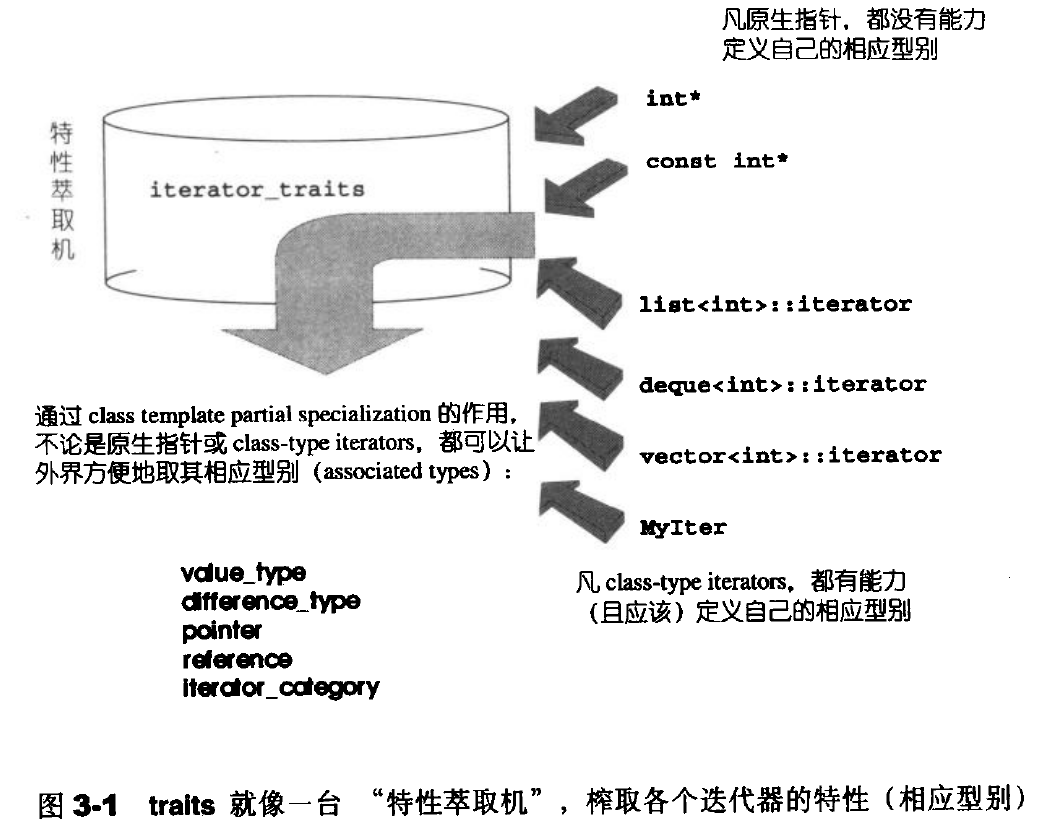
常用的迭代器类型有5种:
- value_type: 迭代器所指对象的型别。
- difference_type:两个迭代器之间的距离,因此也可以用来表示一个容器的最大容量。表示头尾之间的距离参数。其原型是
typedef ptrdiff_t difference_type;使用时可以用typename iterator_traits<I>::difference_type - reference_type:
typedef const T& reference type- 迭代器分为两种
const和非const;不允许/允许改变所指内容的对象。
- 迭代器分为两种
- pointer type 主要还是对象的指针类型。
- iterator_category: 主要用于大规模的迭代器
根据移动特性与施行操作,迭代器被分为5类
- input iterator:这种迭代器所指的对象,不允许外界改变。只读(read only)
- output Iterator:唯写(write only)
- Forward Iterator:允许“写入型”算法(如replace())在此种迭代器所形成的区间上进行读写操作。
- Bidirectional Iterator:可以双向移动。某些算法需要逆向走访某个迭代器区间(例如逆向拷贝某范围内的元素),可以使用Bidirectional Iterators。
- Random Access Iterator: 前四中迭代器都只提供一部分指针算术能力,第五种则涵盖所有指针和算术能力,包括p+n,p-n,p[n],p1-p2,p1小于p2。
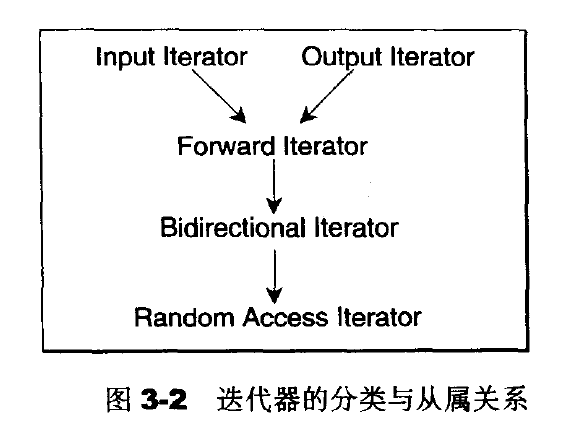 ;
;
3.5 std::iterator的保证
STL提供了一个iterator class 。每个新设计的迭代器都继承自它,可以保证STL所需之规范
template <
class Category,
class T,
class Distance=ptrdiff_t,
class Pointer=T*,
class Reference=T&
>
struct iterator
{
typedef Category iterator_category;
typedef T value_type;
typedef Distance difference_type;
typedef Pointer pointer;
typedef Reference reference;
};
//使用
std::iterator<std::forward_iterator_tag,Item>
纯粹的接口类型类,因此没有额外的负担。
总结:traits编程技法大量用于STL实现品中,利用“内嵌型别”的编程技巧与编译器的template参数推导功能,增强了c++的类型推导能力。
3.6 iterator源码完整重列
//源自 <stl_iterator.h>
struct input_iterator_tag{};
struct output_iterator_tag{};
struct forward_iterator_tag:public input_iterator_tag{};
struct bidirectional_iterator_tag:public forward_iterator_tag{};
struct random_access_iterator_tag:public bidirectional_iterator_tag{};
//迭代器封装类
template <
class Category,
class T,
class Distance=ptrdiff_t,
class Pointer=T*,
class Reference=T&
>
struct iterator
{
typedef Category iterator_category;
typedef T value_type;
typedef Distance difference_type;
typedef Pointer pointer;
typedef Reference reference;
};
//traits
template <class Iterator>
struct iterator_traits{
typedef typename Iterator::iterator_category iterator_category;
typedef typename Iterator::value_type value_type;
typedef typename Iterator::difference_type difference_type;
typedef typename Iterator::pointer pointer;
typedef typename Iterator::reference reference;
}
//为原生指针而设计的traits偏特化版
template <class T>
struct iteraror_traits<T*>
{
typedef random_access_iterator_tag iterator_category;
typedef T value_type;
typedef ptrdiff_t difference_type;
typedef T* pointer;
typedef T& reference;
};
...
SGI STL的私房菜 __type_traits
iterator_traits负责萃取迭代器的特性,__type_traits则负责萃取型别(type)的特性。它提供了一种机制,允许针对不同的型别属性,在编译时期完成函数派送决定。